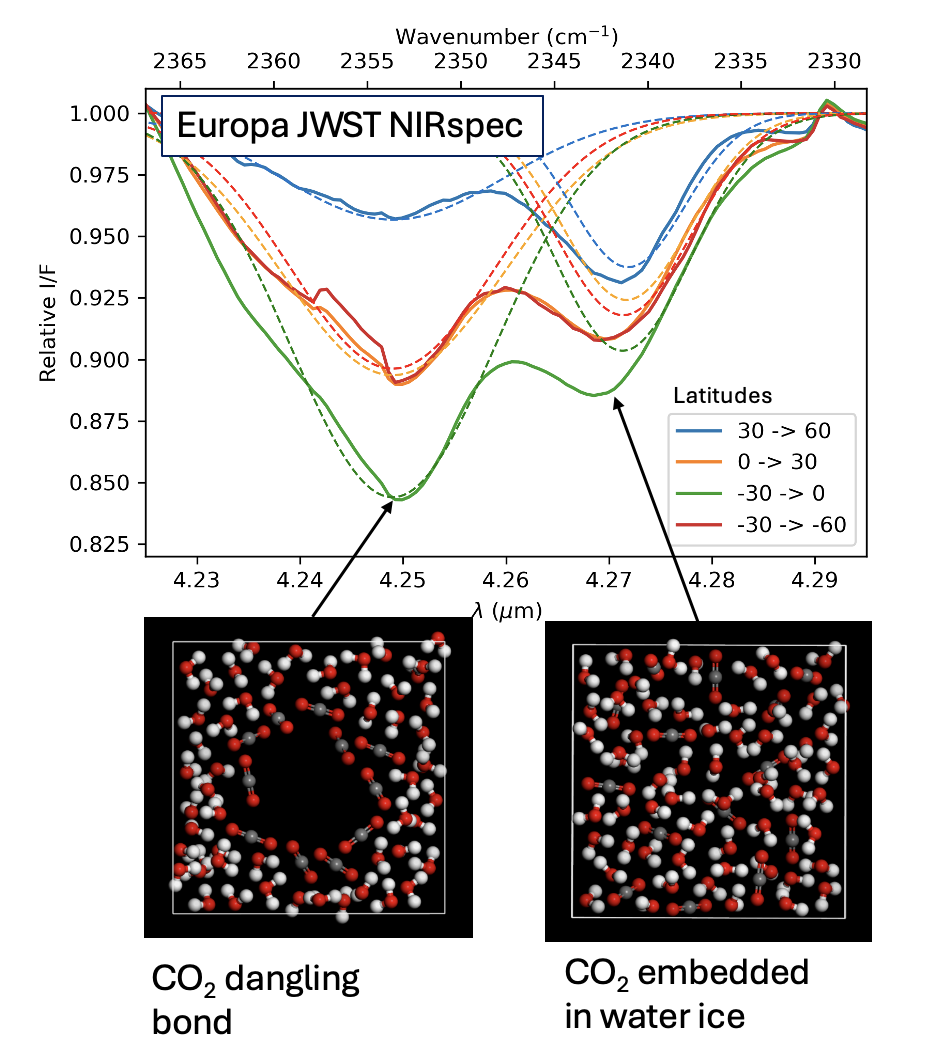Characterization of Carbon Dioxide (CO2) on Ganymede and Europa supported by experiments: The effect of temperature, porosity and mixing with water.
- 1TU Delft, Aerospace Engineering, Planetary exploration, Netherlands (s.m.cazaux@tudelft.nl)
- 2Centro de Astrobiología (CSIC-INTA), Ctra. de Ajalvir, km 4, Torrejón de Ardoz, 28850 Madrid, Spain
- 3Leiden Observatory, Leiden University, P.O. Box 9513, NL 2300 RA Leiden, The Netherlands
- 4Department of Physics, National Central University, Jhongli City, Taoyuan County 32054, Taiwan
- 5Max Planck Institute for Extraterrestrial Physics, Postfach 1312, 85741 Garching, Germany
The surfaces of icy moons are primarily composed of water ice that can be mixed with other compounds, such as carbon dioxide. With the recent JWST observations (Bockelee-Morvan et al. 2024; Villanueva et al. 2023), infrared spectra of Ganymede and Europa’s terrains have been generated with unprecedented resolution, revealing hitherto undetectable variations of the spectral features with the location on the moon. With such high resolution’s data, not only can we identify the species present (in the present case CO2) on the surface, but we can also link their subtle variations to the embedding of the molecule into a host material and/or to energetic processes occurring on the icy moon. The carbon dioxide (CO2) stretching fundamental band observed on Europa and Ganymede appears to be a combination of several bands that are shifting location from one moon to another but also from one terrain to another on the moon itself. We investigated the cause of the observed shift in the CO2 stretching absorption band experimentally. For this purpose, we explored the spectral behavior of CO2 ice by varying the temperature and concentration with respect to water, focusing on the CO2 stretching fundamental band. We analyzed pure CO2 ice and ice mixtures deposited at 10 K under ultra-high vacuum conditions using Fourier-transform infrared (FTIR) spectroscopy and temperature programmed desorption (TPD) experiments. Laboratory ice spectra were compared to JWST observation of Europa's and Ganymede's leading hemispheres. To confirm the assignment of one of the CO2 bands, we simulated IR spectra using density functional theory (DFT) methods, exploring the effect of porosity in CO2 ice. Pure CO2 and CO2-water ice show distinct spectral changes and desorption behaviors at different temperatures, revealing intricate CO2 and H2O interactions. The number of discernible peaks increases from two in pure CO2, referred to as ν3,1 and ν3,2, and to three in CO2-water mixtures, referred to as ν3,1, ν3,2 and ν3,3.
The different CO2 bands were assigned to ν3,1 (2351 cm-1, 4.25 µm) caused by CO2 dangling bonds (CO2 found in pores or cracks) and to ν3,2 (2345 cm-1, 4.26 µm) due to CO2 segregated in water ice, whereas ν3,3 (2341 cm-1, 4.27 µm) is due to CO2 molecules embedded in water ice. The JWST NIRSpec CO2 spectra for Ganymede and for Europa can be fitted with two Gaussians attributed to ν3,1 and ν3,3. For Europa, as shown in Fig.1, ν3,1 is located at lower wavelengths due to a lower temperature. The Ganymede data reveal latitudinal variations in CO2 bands, with ν3,3 dominating in the pole and ν3,1 prevalent in other regions. This shows that CO2 is embedded in water ice at the poles, and it is present in pores or cracks in other regions. Ganymede longitudinal spectra reveal an increase of the CO2 ν3,1 band throughout the day, possibly due to an increase in ice cracks or pores caused by large temperature fluctuations during a day on Ganymede.

References:
Bockelee-Morvan, D., Lellouch, E., Poch, O., et al. 2024, Astronomy & Astrophysics, 681, A27
Villanueva, G., Hammel, H., Milam, S., et al. 2023, Science, 381, 1305
How to cite: Cazaux, S., Schiltz, L., Escribano, B., Muñoz Caro, G., del Burgo Olivares, C., Carrascosa, H., González Díaz, C., Chen, A., Giuliano, M., Caselli, P., and Boshuizen, I.: Characterization of Carbon Dioxide (CO2) on Ganymede and Europa supported by experiments: The effect of temperature, porosity and mixing with water., Europlanet Science Congress 2024, Berlin, Germany, 8–13 Sep 2024, EPSC2024-601, https://doi.org/10.5194/epsc2024-601, 2024.